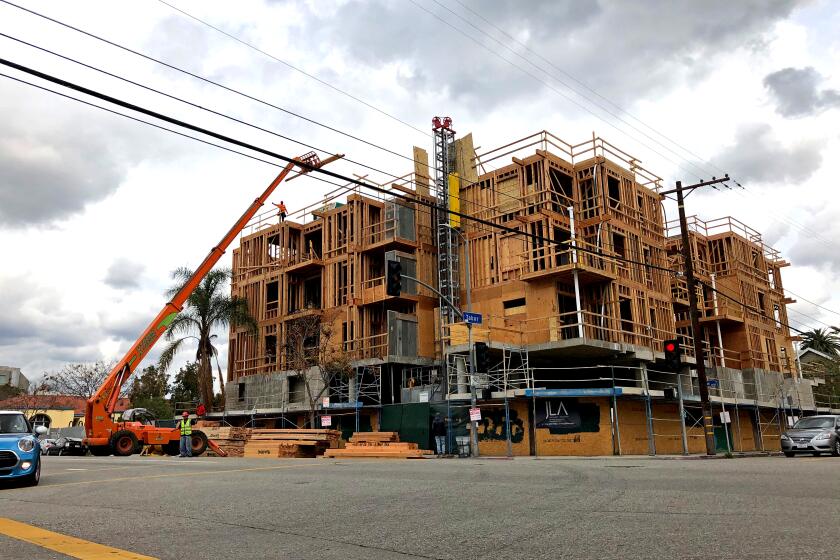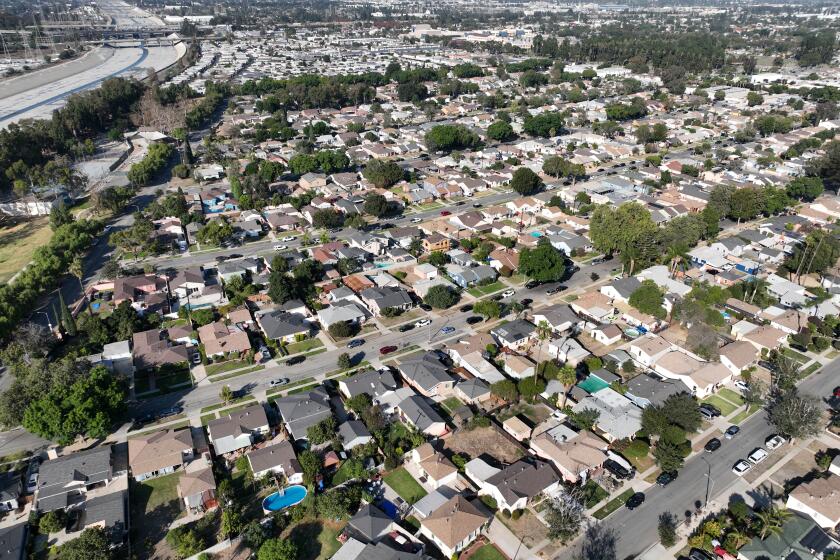Editorial: A test for Mayor Bassâ Planning Commission â support affordable housing or preserve single-family zoning?

The Los Angeles Planning Commission on Thursday will make one of its most consequential decisions in years.
Will L.A. make room for more lower-cost housing in affluent single-family neighborhoods near transit, good schools, jobs and other amenities? Or will the city continue its historic patterns of segregation that have concentrated affordable housing in lower-income, lower-resourced communities?
We think the answer should be obvious. And we hope Mayor Karen Bassâ appointees on the commission agree and back a proposal to allow apartments and townhomes to be built on single-family zoned properties near public transportation stops and major streets in affluent areas, such as Ventura Boulevard and Wilshire Boulevard.
Los Angeles has created an ambitious plan to build more housing, especially affordable housing, throughout the city.
The vote is crucial. The commissionâs recommendation will go to the City Council, which has to approve it and have the new rules in effect by February. Los Angeles is required by state law to plan for 455,000 new units of housing, with nearly 185,000 for low-income residents, and to address housing inequality and segregation. In 2021, city leaders adopted an ambitious plan committing to make room for more affordable homes in high-opportunity communities such as Encino, parts of Hollywood and the Westside, which have lots of jobs, good schools, transit stops, parks and other amenities.
But after city Planning Department staff began developing the programs to carry out the plan, they were flooded by opposition from homeowner groups and others, and were directed by the City Council to take single-family zoned properties off the table for new multifamily housing. That would make it harder for the city to achieve its equity goals.
As the affordability crisis spirals, L.A. should remember that our city used to build dense housing everywhere.
Over the summer, affordable housing advocates pressed the Planning Department to reconsider. The staff report now offers commissioners several options to allow multifamily development on some single-family zoned properties in specific areas where increased density makes sense â walkable to transit and so-called Opportunity Corridors, which include major streets in affluent neighborhoods such as Westwood, Sherman Oaks and the Mid-Wilshire area.
For example, one option calls for allowing construction of two-to-three-story buildings on single-family lots to transition between single-family homes and four- or five-story apartment complexes on busy corridors.
âThis is really designed to build the kind of stuff we built in the early 20th century,â such as fourplexes, small apartment buildings and bungalow courts, said Scott Epstein, policy and research director with Abundant Housing LA. âThis is the multifamily housing really beloved by Angelenos.â
Yes, Southern California needs more housing density, but we can put our sprawl to use without ditching our spacious vibe.
Undoubtedly, the commission will hear from homeowner groups and residents who want to exclude all single-family zoned properties from the affordable housing incentive programs. They will likely argue that there is space to build on land already zoned for apartments and on commercial corridors.
But 76% of the land in affluent neighborhoods is zoned for single-family homes. L.A. cannot promote fair housing and encourage affordable and mixed-income homes in high-resource areas if so much of the land is off limits to apartments and townhomes.
Otherwise, developers will continue to build on land already zoned for multifamily units â and that will displace current tenants by demolishing small, often rent-controlled apartments to build bigger complexes.
Itâs easy to get lost in the weeds when discussing zoning and housing policy ordinances. The staff report to the commission is 2,000 pages and full of acronyms, government code sections, charts and indecipherable maps. But we hope commissioners can cut through the details and get to the heart of the issue. L.A. canât become an affordable, livable city by protecting single-family zoning.
More to Read
A cure for the common opinion
Get thought-provoking perspectives with our weekly newsletter.
You may occasionally receive promotional content from the Los Angeles Times.












